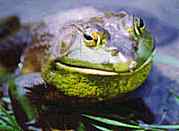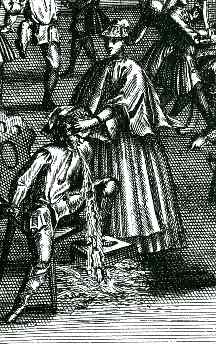Contact |
News! |
Books |
Home |
Contact |
News! |
Books |
Home |
 In 1642, Mrs. Catharina Geisslerin was widely known as "the
toad-vomiting woman of Germany." She told people that she had
swallowed tadpoles in swamp water, and that frogs were thriving in her
intestinal tract. Whenever she drank milk, the frogs would hop about
madly. Despite initial skepticism, she convinced physicians that
amphibians were in her digestive system -- especially after she
vomited fully-grown frogs (sometimes living) for two years in front of
famous professors and medical consultants!
In 1642, Mrs. Catharina Geisslerin was widely known as "the
toad-vomiting woman of Germany." She told people that she had
swallowed tadpoles in swamp water, and that frogs were thriving in her
intestinal tract. Whenever she drank milk, the frogs would hop about
madly. Despite initial skepticism, she convinced physicians that
amphibians were in her digestive system -- especially after she
vomited fully-grown frogs (sometimes living) for two years in front of
famous professors and medical consultants!

Theodorus Döderlein vomits frogs and newts. (From Georg Abraham Mercklin's De Incantamentis, 1715.) |
Throughout the 17th and 18th centuries, there were many stories of people vomiting amphibians, and most German pathological museums contained vomited amphibians that allegedly lived for years in a person's digestive tract. For example, in 1694, Theodorus Döderlein of southern Germany vomited 21 newts and 4 frogs (see Figure). In 1834, Mrs. Henriette Pfenning vomited frogs in front of applauding crowds of spectators. (She later admitted her hoax -- she stashed the frogs inside her skirt pockets and pretended to vomit the frogs.) |
pagophagia - ice-eating xylophagia - wooden toothpick eating coniophagia - a lust for dust geophagia - clay or dirt eating amylophagia - the consumption of laundry starch and paste coprophagia - feces eating
 Cliff is the author of 30 books including the The Lobotomy Club, which
is part of the
Neoreality science-fiction series in which
people explore parallel realities.
Cliff is the author of 30 books including the The Lobotomy Club, which
is part of the
Neoreality science-fiction series in which
people explore parallel realities.
"The Woman Who Vomited Frogs" copyright Cliff Pickover. |
 If you want to read additional stories involving medical mysteries,
see my popular book
The Girl Who Gave Birth to Rabbits: A True Medical
Mystery.
If you want to read additional stories involving medical mysteries,
see my popular book
The Girl Who Gave Birth to Rabbits: A True Medical
Mystery.